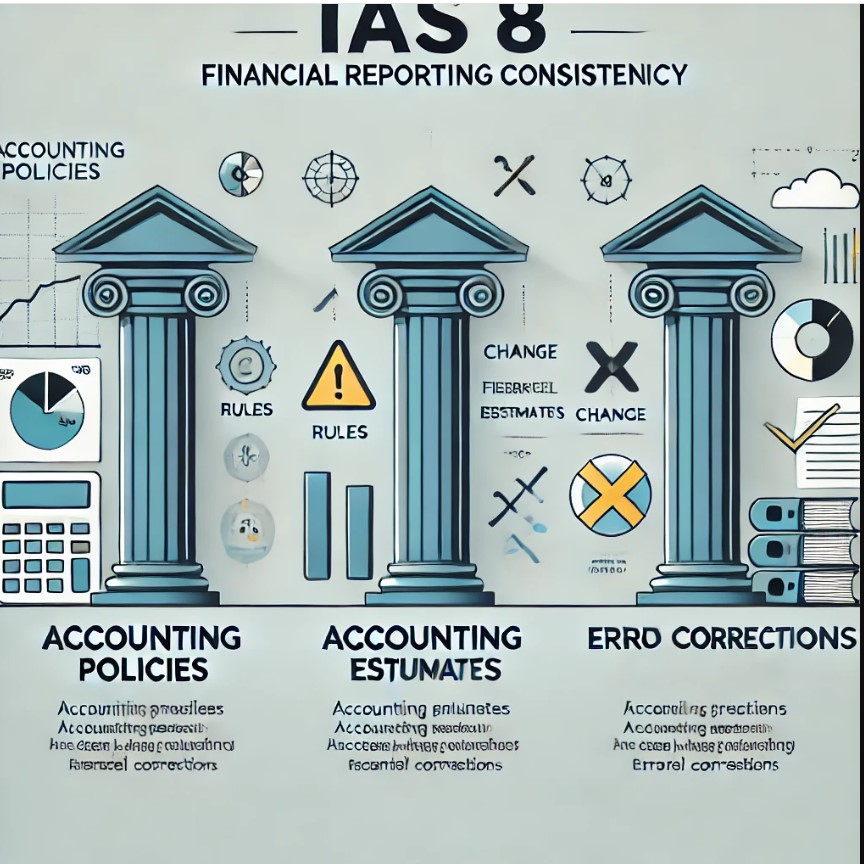
Don’t Let Errors Haunt Your Balance Sheet — Follow IAS 8
Wanna stay consistent and credible in your global financial reporting? Here's why IAS 8 matters.
In the realm of financial reporting, precision is essential — but so is the ability to adapt. Businesses evolve, information improves, and occasionally, errors surface. The question is: how do you reflect these changes in your financial statements without losing comparability or trust?
IAS 8: Accounting Policies, Changes in Accounting Estimates and Errors is the standard that answers that question. It guides how companies should apply accounting policies consistently, revise estimates when necessary, and correct mistakes responsibly — all while upholding transparency and credibility.
“Numbers don’t lie — but only when they’re told right.”
Consistency in accounting isn’t just a standard, it’s a responsibility.IAS 8 ensures your financial story stays clear, comparable, and credible — even when the facts change.
Let’s decode IAS 8 and understand how it safeguards the integrity of financial reporting.
🎯 What is IAS 8 All About?
IAS 8 addresses three essential components of financial reporting:
- Accounting Policies
- Changes in Accounting Estimates
- Correction of Errors
These concepts help ensure that financial statements remain reliable, comparable, and relevant, even as business conditions or understanding of facts change.
📘 1. Accounting Policies: Building a Consistent Foundation
DefinitionAccounting policies are the specific principles and rules applied by an entity in preparing and presenting financial statements.
When Can a Policy Be Changed?A change in accounting policy is permitted when:
- Mandated by a new or revised IFRS, or
- The new policy provides more relevant and reliable information
Unless otherwise specified, changes in accounting policies must be applied retrospectively:
- Restate prior period figures
- Adjust opening balances of assets, liabilities, and equity
- Provide comparative information as if the new policy had always been applied
A company moving from the cost model to the revaluation model for investment properties (under IAS 40) must restate prior period values to reflect the revaluation model.
📈 2. Accounting Estimates: When Judgement Evolves
DefinitionEstimates are used when the value of an asset or liability cannot be determined precisely, and management must rely on judgment and experience.
- Depreciation and amortisation
- Provisions for doubtful debts or warranties
- Fair value assessments
- Inventory obsolescence
Changes in estimates are not errors — they result from updated data or better insight. IAS 8 requires these changes to be applied prospectively:
- Affect the current period and future periods only
- No restatement of previous financial statements
If the estimated useful life of machinery is reduced from 10 to 7 years, the new depreciation amount is applied going forward, without changing past records.
❌ 3. Prior Period Errors: Fixing the Past
What Qualifies as an Error?Errors arise from:
- Misinterpretation or misuse of available information
- Mathematical mistakes
- Oversight or fraud
- Incorrect application of an accounting policy
Material errors are corrected retrospectively, unless it's impracticable:
- Restate comparative information for prior periods
- Adjust opening balances
- Clearly disclose the nature and impact of the error
If full retrospective restatement is not feasible, correct from the earliest practicable date and explain the limitation.
Example:An omitted lease under IFRS 16 in a prior year must be recognised and prior year financials restated accordingly.

📢 Disclosure Requirements: The Power of Transparency
IAS 8 emphasises not just correcting or changing — but explaining.
Mandatory Disclosures Include:- The nature and reason for the change in policy or estimate
- The financial effect on current and prior periods
- Amounts of adjustments made
- Why retrospective application/correction was impracticable (if applicable)
💼 Why IAS 8 Matters More Than Ever
- Enhances comparability across periods and entities
- Improves investor confidence through transparency
- Minimises audit risk by formalising treatment of changes and errors
- Supports regulatory compliance in IPOs, listings, and cross-border reporting
- Strengthens internal controls around estimation and policy application
✅ Final Thoughts: Let Standards Shape the Story, Not Distort It
IAS 8 is not about penalising change — it’s about ensuring change is documented and understood. Whether it’s a strategic shift in accounting method, a refinement of an estimate, or correction of a prior oversight, this standard ensures users of financial statements aren’t left in the dark.
In an age where transparency is currency, following IAS 8 diligently means numbers that not only add up — but make sense.
When your numbers change, do your disclosures keep up — or are you missing the essence of IAS 8?
